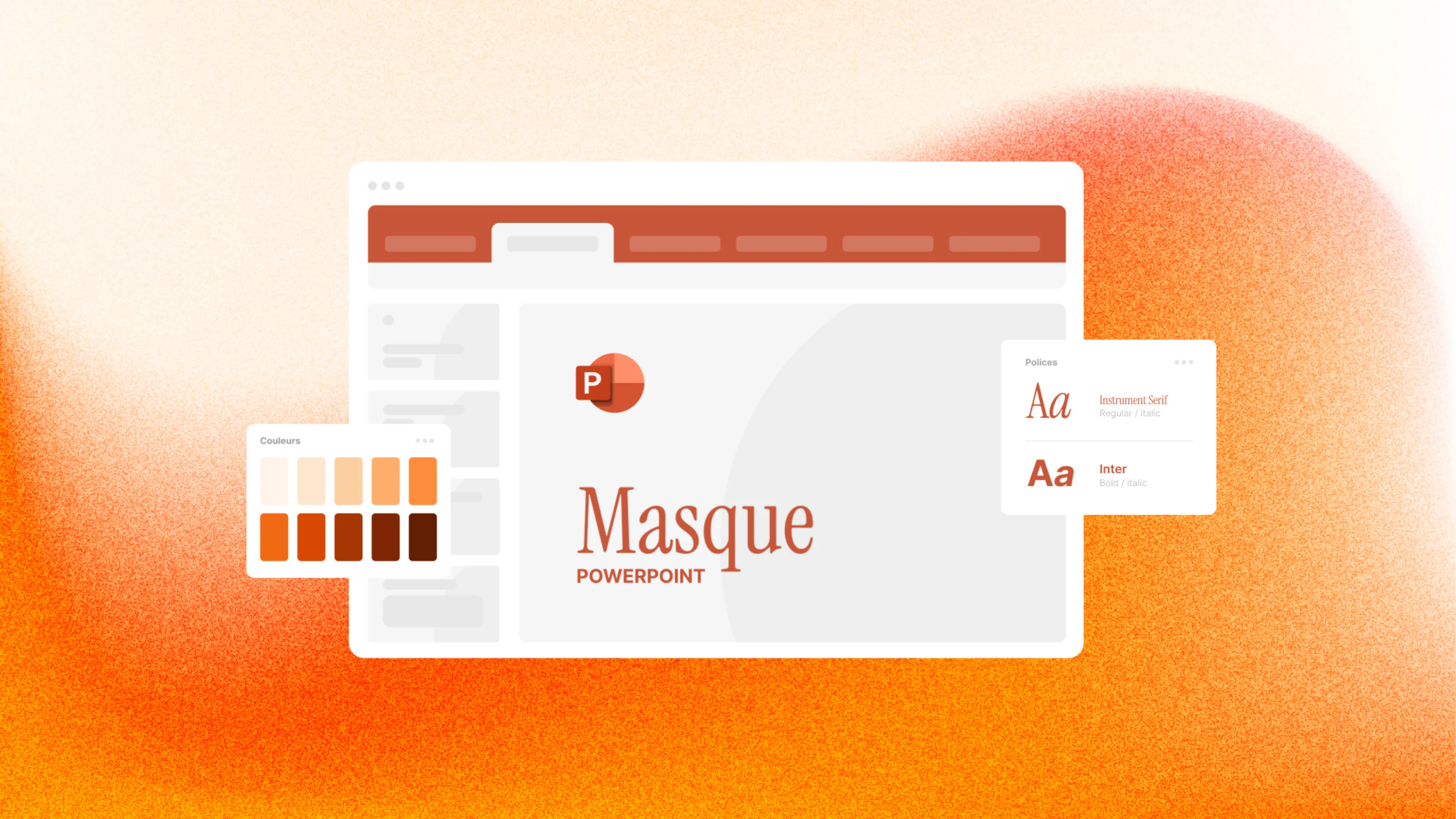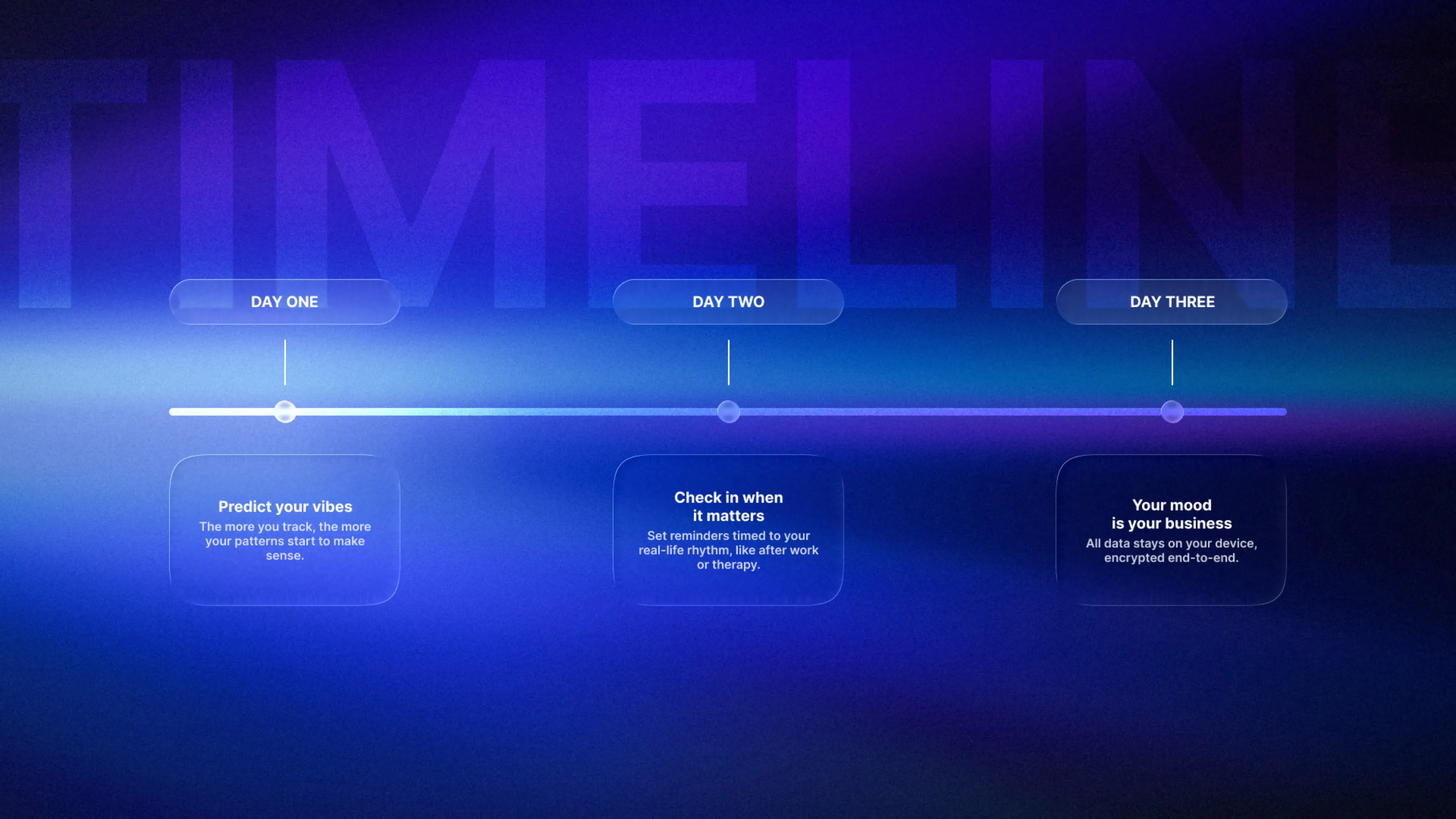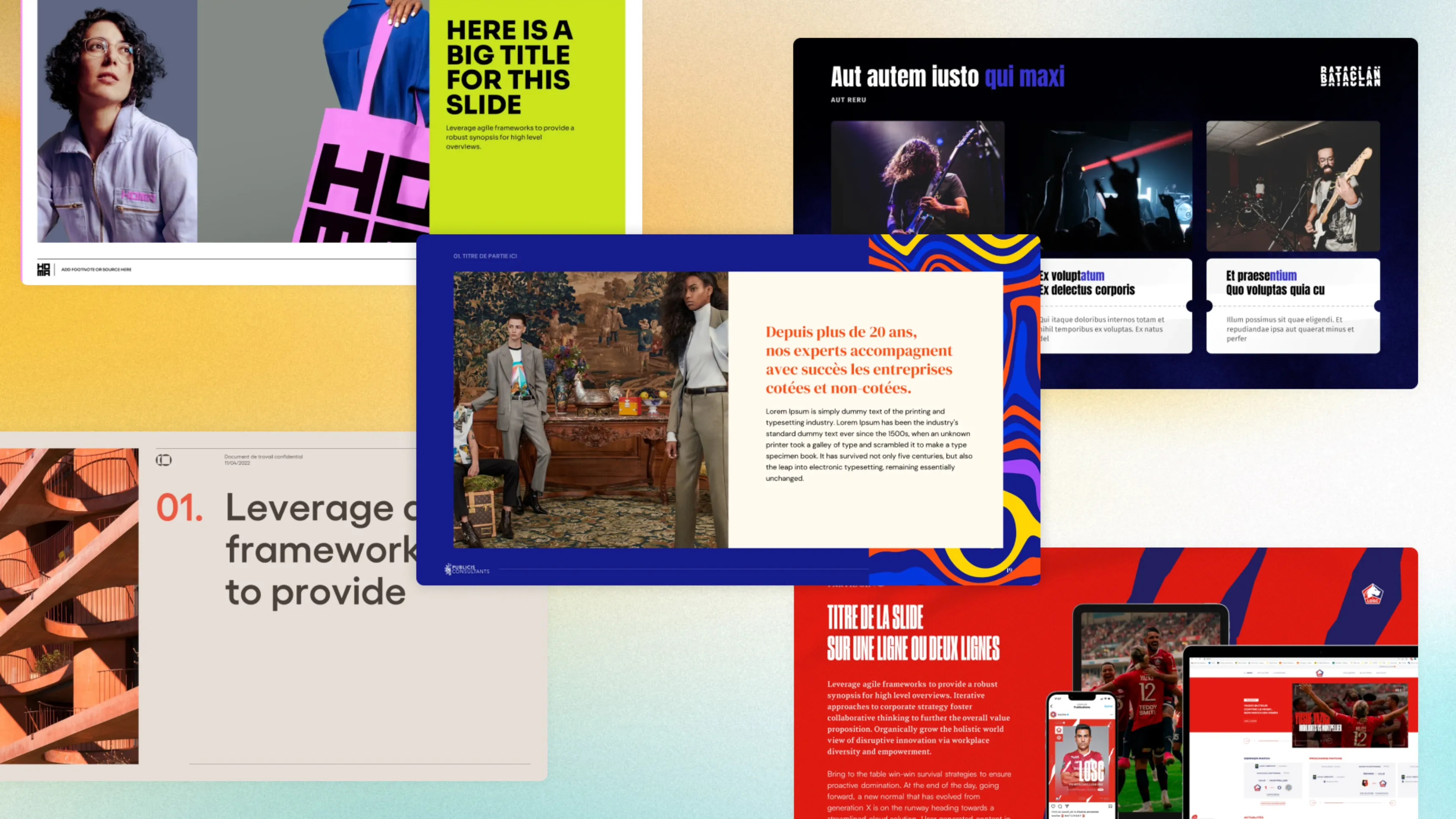.svg)
How to create a professional PowerPoint slide master
The slide master in PowerPoint is a master template that defines the default look and layout of all the slides in a presentation. It contains font settings, color settings, logos, footers, and content placeholders. Any changes made to the master automatically affect all the slides that use it, ensuring consistency and efficiency.
Author
Jérôme Bestel
Updated on
November 14, 2025
Created on
Category
Tutorials


Join the thousands of businesses and executives who have trusted Slidor to turn their slides into high-impact presentations.



Definition of Slide Master
The slide master constitutes the structural foundation of any professional PowerPoint presentation. It operates on a three-level hierarchy: the master slide defines global parameters, layouts inherit these parameters while offering specific structures, and individual slides apply the final content.

Hierarchical structure of the system:
| Level | Element | Main function | Scope |
|---|---|---|---|
| 1 | Master slide | Global parameters (fonts, colors, logo) | Entire presentation |
| 2 | Layouts | Specific structures (title+content, 2 columns, etc.) | Slide groups |
| 3 | Slides | Final content | Individual slide |
💡 Key Point: The difference between master and layout is essential. The master controls universal elements (logo, colors, fonts), while layouts organize content structure.
Why Master Slide Masters in 2026?
PowerPoint creation workflows have evolved. Modern agencies and professionals now favor efficiency and flexibility over absolute control through placeholders. A well-designed master in 2025 reduces production time by 60 to 70% while allowing maximum visual creativity. Our presentation design agency creates custom templates that combine brand rigor and creative flexibility.

Two Approaches: Traditional vs Modern
Traditional Approach (Placeholder-Heavy)
The classic approach consists of creating numerous layouts with placeholders everywhere. Every element is locked in the master: title areas, content zones, image positions, chart locations.
Advantages:
- Strict control of brand guidelines
- Ideal for large organizations with rigid branding
- Users cannot "break" the design
Disadvantages:
- Very long initial creation (4-6 hours)
- Lack of visual flexibility
- Requires creating a layout for each specific case
- Difficult to maintain and update
Modern 2025 Approach (Minimal Master)
The modern method favors a minimal master with only essential elements, supplemented by pre-made slides that users duplicate and customize.
Philosophy:
- Master = Logo + Font + Colors + Footer (invariant elements)
- Library of pre-designed slides in normal mode (unlocked)
- Users duplicate slides and adapt content
Advantages:
- Quick creation (1-2 hours maximum)
- Great visual flexibility
- Design variety without multiplying layouts
- Easy to enrich and evolve
- Agile workflow adapted to agencies
Disadvantages:
- Less strict control (users can modify)
- Requires team awareness
🎯 2025 Recommendation: For agencies, freelancers, and SMEs, the modern approach is vastly superior. Reserve the traditional approach for large corporations with strict legal constraints.
Comparison of Both Approaches
| Criterion | Traditional Approach | Modern 2025 Approach |
|---|---|---|
| Creation time | 4-6 hours | 1-2 hours |
| Number of layouts | 15-25 layouts | 3-5 minimal layouts |
| Design flexibility | Low (everything is locked) | High (modifiable slides) |
| Use cases | Large organization, strict branding | Agencies, SMEs, agile workflows |
| Maintenance | Complex (numerous layouts) | Simple (adding pre-made slides) |
| Visual variety | Limited to created layouts | Unlimited (duplicable slides) |
| Learning curve | Medium (understanding layouts) | Easy (duplicate-modify) |
How to Create a Modern Master in 2026
Step 1: Minimal Master Configuration
Access Master mode:
1. View > Slide Master
2. Select the master slide (first thumbnail at top)
Elements to configure:
A. Fonts and colors (15 min)
- Fonts: Slide Master > Fonts > Customize Fonts
- Title font: Montserrat Bold / Calibri Bold
- Body font: Roboto / Calibri Regular
- Colors: Slide Master > Colors > Customize Colors
- Define 3-4 main colors from your brand guidelines

B. Logo and recurring elements (10 min)
- Insert > Pictures: Add logo (PNG format, 300 DPI)
- Recommended position: Lower right or upper left corner
- Size: 1.5 to 3 cm width
C. Footer (5 min)
- Configure via Insert > Header & Footer
- Position and style defined in master slide

⚠️ Warning: Do NOT create complex placeholders in the master slide. Keep it clean with only logo, fonts, colors, and footer.
Step 2: Creating Essential Layouts
Limit yourself to 3-5 layouts maximum:
1. Title slide (keep the default one)
2. Title + Empty area (for free content)
3. Section (to separate chapters)
4. Blank slide (background + logo only)
Creating a layout:
- Slide Master > Insert Layout
- Rename: Right-click > Rename (e.g., "Free Content")
- Add only a Title placeholder if necessary
Close Master mode: Click Close Master View
Step 3: Creating the Pre-Made Slide Library
Back to normal mode (this is where the magic happens):
1. Create 10-15 visually polished slides with different designs:
- Quote slide (centered text + author)
- Key figure slide (large format KPI)
- 2-column slide (text + image)
- 3-column slide (comparison)
- Timeline slide (horizontal chronology)
- Full image slide + title overlay
- Data table slide
- Icons + text slide
- Etc.
To enrich your library, integrate quality visuals that enhance the visual impact of your templates.
2. Organize these slides at the beginning of the presentation in a "LIBRARY" section
3. Save as template: File > Save As > .potx format
Team usage:
- Open the template
- Browse the library
- Duplicate the desired slide (Ctrl+D)
- Replace content (text, images)
- Delete library slides before final export
💡 Pro Tip: Create a PowerPoint section named "🔧 LIBRARY - DO NOT USE DIRECTLY" containing your pre-made slides. Users immediately understand they should duplicate, not modify directly.
Step 4: Usage Workflow
To create a new presentation:
1. Open the .potx template
2. Delete unnecessary slides from the library (or keep them hidden)
3. Duplicate relevant slides for your content
4. Customize text, images, data
5. Adjust visually if necessary (allowed since not locked)
6. Export as final PDF or PPTX
Production time:
- Initial template setup: 1-2h (only once)
- Creating a 20-slide presentation: 45 min - 1h30
- Time savings vs starting from scratch: 60-70%
To ensure consistency and professionalism, save your default template so that every new presentation automatically inherits your custom master.
Common Mistakes to Avoid
1. Overuse of Placeholders (Traditional Approach)
Mistake: Creating 20 layouts with placeholders everywhere, thinking it saves time.
Consequence: Rigid template, impossible to create original designs, user frustration.
Solution: Adopt the modern approach with minimal master + pre-made slides.
2. Direct Slide Modification Instead of Master
Mistake: Manually changing font on each slide instead of modifying the master.
Consequence: Visual inconsistencies, impossible to update globally.
Solution: Always modify recurring elements (logo, fonts, colors) in the master. Reset "corrupted" slides: Right-click > Reset Slide.
3. Accumulation of Multiple Masters
Mistake: Copy-pasting slides between presentations, importing multiple different masters.
Consequence: Heavy file, confusing navigation, inconsistent styles.
Solution: Use "Keep Text Only" when pasting, then reapply the layout from your main master. To quickly create your professional PowerPoint templates, our agency designs optimized masters according to 2025 best practices.
📋 Verification Checklist:
- [ ] Single master slide in the presentation
- [ ] Maximum 5 layouts in the master
- [ ] Library of 10-15 pre-made slides in normal mode
- [ ] Logo, fonts, and colors consistent everywhere
- [ ] Template saved as .potx accessible to the team
Frequently Asked Questions
What exactly is a PowerPoint slide master?
The PowerPoint slide master is a master slide that defines the overall appearance of your presentation: fonts, colors, logo, footer. Any modification to the master automatically applies to all slides using it. In 2025, the modern approach recommends a minimal master (invariant elements only) supplemented by duplicable pre-made slides.
How do I access the slide master?
Click View > Slide Master in the top ribbon. The interface switches to master editing mode. To return to normal mode, click Close Master View. Windows shortcut: Alt + V then M.
What is the difference between master and layout?
The master defines universal elements (logo, colors, fonts) applied to the entire presentation. Layouts are specific structures (title+content, 2 columns, etc.) that inherit from the master. In the modern approach, limit layouts to the strict minimum (3-5) and create pre-made slides instead.
How long does it take to create a modern master?
Modern approach: 1-2 hours maximum (30 min master configuration + 1h creating pre-made slides). Traditional approach: 4-6 hours (creating 15-25 layouts with placeholders). The modern approach is 3 times faster and more flexible.
Can you mix both approaches?
Yes, for certain organizations. Create a minimal master with 3-5 essential layouts, AND a library of pre-made slides. This offers a consistent basic framework (traditional approach) with the flexibility of duplicable slides (modern approach). It's the best of both worlds for medium-sized teams.
How do I share the template with my team?
Save your configured presentation (master + slide library) in .potx format via File > Save As. Host this file on a shared space (OneDrive, SharePoint, Google Drive, network server). Collaborators open the .potx to create a new presentation with the master and library pre-loaded.
My master modifications don't appear, why?
Two main causes: 1) You manually modified the slides in question (local overrides). Solution: Right-click > Reset Slide. 2) The slides use another master (multiple masters problem). Solution: Check in Master mode and delete unused masters.
Conclusion
In 2025, PowerPoint slide master creation favors efficiency and flexibility over absolute control. The modern approach — minimal master with logo, fonts, essential colors, supplemented by a library of duplicable pre-made slides — establishes itself as the reference method for agencies and SMEs. It divides initial creation time by 3 while offering unlimited visual variety. Reserve the traditional approach (layouts with multiple placeholders) for large organizations with strict branding constraints. A well-designed master is not one that controls everything, but one that facilitates rapid creation of presentations that are visually consistent and impactful.



















